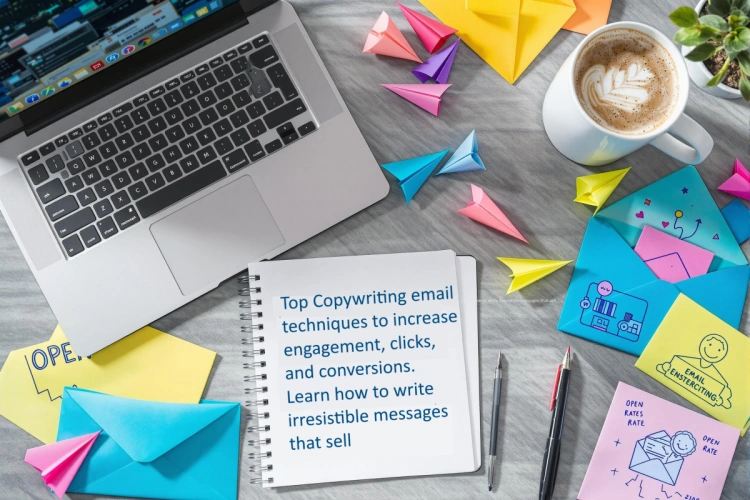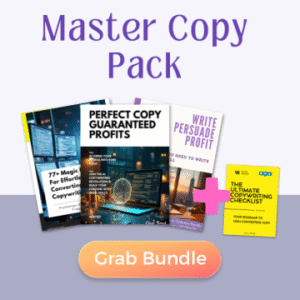Email remains one of the most powerful marketing channels available today, with an unmatched ROI of $36 for every $1 spent. At the heart of successful email marketing lies effective copywriting email techniques that engage readers and drive them to action. This comprehensive guide will walk you through everything you need to know about crafting compelling email copy that converts.
Why email copywriting matters
The average professional receives 121 emails daily. Your message competes with dozens of others for attention in crowded inboxes. Mastering copywriting email skills has become essential for anyone looking to stand out and achieve marketing goals. Great email copy opens doors to higher engagement, increased conversions, and stronger customer relationships.
The difference between mediocre and exceptional copywriting email techniques often determines whether your message gets opened, read, and acted upon. With inbox competition fiercer than ever, the words you choose can make or break your campaign results.
Recommended reading:
- Email copywriting business: Essential strategies for success
- Email copywriting earning & How to maximize your income
- Email copywriting tools to crafting high-converting messages
- Email copywriting exercises for crafting messages that get results
Key elements of effective email copywriting
Subject lines that grab attention
Your subject line serves as the gateway to your email content. Here are proven tactics:
- Create curiosity gaps that entice readers to learn more
- Use numbers to set expectations and provide structure
- Ask compelling questions that resonate with your audience
- Invoke urgency when appropriate (but avoid false urgency)
- Keep subject lines under 50 characters for optimal display
Strong subject lines make specific promises your email will fulfill. Test phrases like “Quick tip for…” or “The secret to…” which often drive higher open rates.
Personalization beyond the first name
Modern email copywriting extends personalization well beyond using someone’s name. Consider these approaches:
- Reference past purchases or browsing behavior
- Segment based on demographic information
- Acknowledge previous interactions with your brand
- Tailor content to specific interests or needs
- Match tone and style to audience preferences
Effective copywriting email strategies leverage data to create relevant, individualized experiences that resonate with readers at a deeper level.
Clear and compelling calls to action
Every marketing email needs a clear purpose. Your call to action (CTA) should:
- Stand out visually from surrounding content
- Use action-oriented language that creates momentum
- Communicate specific value the reader will receive
- Eliminate friction or barriers to taking the next step
- Match the commitment level to the relationship stage
Limit each email to one primary CTA to avoid confusion. If multiple options exist, establish a clear hierarchy of importance through design and placement.
The step-by-step process for writing persuasive email copy
Know your audience deeply
Before writing a single word, understand who will receive your message. Create detailed reader personas that include:
- Key pain points and challenges they face
- Goals and aspirations they want to achieve
- Level of awareness about your solution
- Communication preferences and tone expectations
- Objections they might have to your offer
This foundation informs every subsequent decision in your copywriting email process.
Craft your value proposition
Clarify exactly what makes your offer unique and valuable. Ask yourself:
- What specific problem does this solve?
- How does our solution differ from alternatives?
- What proof points support our claims?
- Which benefits matter most to this audience?
- How can we communicate this concisely?
Your value proposition should appear early in your email to immediately hook readers and justify their continued attention.
Write an engaging opener
The first few sentences determine whether readers continue or click away. Effective openers:
- Acknowledge a relevant pain point or desire
- Establish common ground with the reader
- Make a bold or intriguing statement
- Tell the beginning of a story
- Offer an immediate useful insight
Aim to write an opener that flows naturally into your main message without feeling disconnected or gimmicky.
Develop your main message
The body of your email should deliver on the promise made in your subject line and opener. Follow these principles:
- Focus on benefits rather than features
- Use concrete, specific language instead of vague claims
- Break complex ideas into digestible chunks
- Maintain a consistent voice throughout
- Address potential objections proactively
Keep paragraphs short and scannable, knowing most readers will skim rather than read every word.
End with a strong closing
Your email conclusion should:
- Reiterate the core value proposition
- Create a sense of urgency when appropriate
- Transition smoothly to your call to action
- Remove any final barriers to action
- Leave readers feeling positive about next steps
Avoid introducing new information in your closing that might distract from your primary goal.

Formulas and templates for different email types
Welcome emails that convert
Welcome emails typically see 4x the open rate of standard marketing messages. An effective welcome email:
- Thanks the subscriber for joining
- Sets expectations for future communications
- Delivers immediate value or a quick win
- Introduces your brand story briefly
- Suggests a logical next step
Welcome sequences often outperform single emails, with three to five messages introducing different aspects of your offering.
Promotional emails that drive sales
When crafting promotional emails, structure your copy like this:
- Open with the core benefit of your offer
- Explain key features through the lens of outcomes
- Include social proof to validate your claims
- Address common objections preemptively
- Create urgency with deadlines or limited availability
- Close with a value-focused call to action
Emphasize what the reader stands to gain rather than what they must give up.
Nurture emails that build relationships
Nurture emails focus on delivering value before asking for commitment. Their structure typically includes:
- A helpful insight or tip the reader can use immediately
- Contextual information explaining why this matters
- Brief connection to your broader expertise or solution
- Subtle positioning of your offerings as the logical next step
- Low-pressure invitation to learn more or engage further
These emails build authority and trust over time, making later conversion efforts more effective.
Re-engagement emails to win back attention
When subscribers become inactive, targeted re-engagement emails can help. Follow this approach:
- Acknowledge the gap in engagement directly
- Express genuine interest in continuing the relationship
- Offer exceptional value to recapture attention
- Present a clear reason to re-engage now
- Make the next step incredibly easy to take
Sometimes acknowledging that it might be time to part ways can paradoxically increase response rates from inactive subscribers.
Recommended reading:
- Best AI for Copywriting & How to Choose the Right One
- Copywriting social media for each platform
- Copywriting for products: Guide to writing descriptions that sells
- Copywriting for ads to double your conversion rates
- Skills in Copywriting: A Guide to Mastering the Craft
Tips to improve open rates and engagement
Subject line optimization techniques
Beyond basic subject line principles, consider these advanced approaches:
- Test subject lines that reference current events or trends
- Experiment with emoji placement and impact on open rates
- Try using the recipient’s location or other personalized data
- Create occasional pattern interrupts that break from your norms
- Analyze which emotional triggers resonate with your audience
Track metrics over time to identify patterns specific to your audience and industry.
Preheader text strategies
The preheader text (preview text) appears after your subject line in most email clients. Optimize it by:
- Extending or complementing your subject line message
- Adding information that increases curiosity
- Including a benefit not mentioned in the subject line
- Testing questions versus statements
- Avoiding redundancy with the subject line content
Many marketers neglect this valuable real estate, giving you an advantage when used strategically.
Optimal sending times and frequency
Timing greatly impacts email performance. Consider these factors:
- Test sending at different times throughout the week
- Segment your audience by engagement patterns
- Adjust frequency based on purchase cycle and involvement
- Create expectations and maintain consistent patterns
- Monitor for signs of fatigue or decreased engagement
The ideal timing varies by industry and audience, making testing essential for optimization.
Common mistakes to avoid in email copywriting
Focusing on features instead of benefits
Many copywriters emphasize what their product does rather than how it improves the customer’s life. Always translate features into concrete outcomes the reader will experience.
Writing for skimmers only
While formatting for scannability matters, don’t sacrifice substance. Create multiple layers of content that reward both quick skimmers and those who read thoroughly.
Neglecting mobile optimization
Over 60% of email opens occur on mobile devices. Ensure your copy works well on small screens by:
- Using shorter paragraphs and sentences
- Placing critical information early in the message
- Testing how your design renders across devices
- Making CTAs easy to tap with a finger
- Avoiding fonts smaller than 14px
Mobile-hostile emails face immediate deletion regardless of content quality.
Overusing jargon and buzzwords
Clear communication trumps impressive vocabulary. Write as though explaining to a smart friend rather than showcasing industry terminology or complex concepts.
Missing the emotional connection
Purely rational arguments rarely drive action. Connect with readers emotionally by:
- Telling relevant stories that illustrate your points
- Using sensory language that creates vivid mental images
- Addressing deeper motivations beyond surface-level needs
- Acknowledging feelings associated with their challenges
- Creating a sense of belonging or shared purpose
The most effective copywriting email techniques balance logic and emotion.
A/B testing your email copy
Elements worth testing
Focus your testing efforts on these high-impact elements:
- Subject lines and preheader text variations
- Different opening paragraphs and hooks
- Various CTA phrasings and placements
- Long versus short copy approaches
- Formal versus conversational tones
Begin with elements that drive initial engagement before testing deeper content variations.
Setting up valid tests
Follow these principles for meaningful results:
- Test only one element at a time for clear causation
- Use sample sizes large enough for statistical significance
- Determine success metrics before launching tests
- Account for variables like sending time and day
- Document learnings for future application
Systematic testing over time yields compounding improvements to your results.
Interpreting results accurately
Look beyond surface metrics when evaluating tests:
- Consider the full conversion path, not just initial clicks
- Segment results by audience characteristics
- Analyze qualitative feedback alongside numbers
- Watch for unexpected secondary effects
- Balance short-term results with long-term brand impact
Sometimes lower open rates lead to higher quality engagement from truly interested prospects.
Advanced techniques for email copywriting
Storytelling frameworks
Stories capture attention and drive memorability. These structures work particularly well:
- Before/After/Bridge: Show the problem, the solution, and the transformation
- Problem/Agitation/Solution: Identify pain, intensify it, then relieve it
- Hero’s Journey: Position the reader as the hero facing and overcoming challenges
- Curiosity Loops: Open questions early that get answered later
Effective stories in copywriting email content create emotional investment that facts alone cannot achieve.
Psychology principles that drive action
Leverage these psychological triggers thoughtfully:
- Reciprocity: Offer genuine value before asking for action
- Social proof: Show others similar to the reader taking desired actions
- Scarcity: Highlight limited availability of truly constrained offers
- Authority: Demonstrate relevant expertise and credibility
- Consistency: Connect requested actions to readers’ existing beliefs
- Unity: Create a sense of shared identity or common goals
The ethical application of these principles can dramatically increase response rates.
Voice and tone considerations
Develop a consistent yet flexible voice that:
- Aligns with your overall brand personality
- Adjusts appropriately to different message contexts
- Speaks directly to the reader as an individual
- Balances professionalism with approachability
- Creates a sense of conversation rather than broadcast
Document voice guidelines to maintain consistency across team members and campaigns.
Tools and resources for email copywriting
Writing assistance tools
These tools can enhance your copywriting process:
- Hemingway Editor for readability and conciseness
- Grammarly for error-free, polished content
- CoSchedule’s Headline Analyzer for subject line testing
- Thesaurus tools for avoiding repetitive language
- Voice-to-text apps for capturing conversational ideas
Use these as refinement tools rather than primary creators of your message.
Email testing platforms
Validate your emails before sending with:
- Litmus or Email on Acid for rendering tests
- Subject line testers like SubjectLine.com
- Spam filter checkers to ensure deliverability
- Heat map tools to track reader attention patterns
- A/B testing functionality in your email platform
Testing catches issues that could undermine otherwise strong copy.
Learning resources for ongoing improvement
Continue developing your skills through:
- Industry blogs like Copyhackers and Really Good Emails
- Books on persuasion psychology and copywriting
- Swipe files of effective emails from various industries
- Courses specific to email marketing copy
- Communities where you can receive peer feedback
The most successful email copywriters never stop learning and refining their approach.
Bringing it all together
Effective copywriting email strategies combine art and science. They require understanding human psychology, mastering writing techniques, and continuously testing to improve results. Start by implementing the foundational elements covered in this guide, then gradually incorporate more advanced techniques as you gain experience and confidence.
Remember that even small improvements to your email copy can yield significant results over time. A 5% increase in open rates or a 2% lift in click-throughs compounds across thousands of emails to produce substantial business impact.
The most important factor in successful email copywriting remains relevance to your specific audience. No technique or formula can compensate for messages that fundamentally miss the mark in addressing reader needs and interests. When you truly understand your audience and craft messages that serve them while advancing your goals, email becomes an incredibly powerful connection point with your customers.
Start applying these copywriting email principles today, and watch your engagement and conversion metrics transform in the weeks and months ahead.

